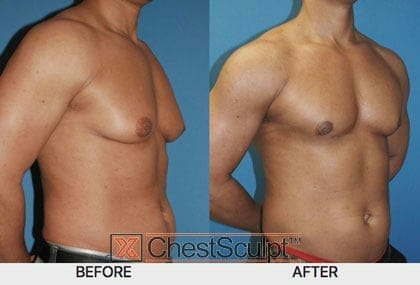Will estrogen blockers get rid of gynecomastia?

Estrogen blockers are a common medical treatment used to get rid of gynecomastia and treat gynecomastia symptoms. Gynecomastia occurs when men have a female chest appearance due to an enlargement of the breast gland behind the nipple-areola complex. Most gynecomastia cases need surgery, but certain non-surgical treatments can minimize, eliminate, or improve the symptoms associated with gynecomastia.
Gynecomastia is usually caused by a hormone imbalance that occurs during puberty. Estrogen, the predominant sex hormone in women, is formed when testosterone is converted to estrogen by an enzyme called aromatase found in the body’s fat cells. During puberty, testosterone levels increase dramatically, and subsequently estrogen due to the high levels of testosterone that are converted by the aromatase enzyme. This higher estrogen level is what causes the development of breast glands in males. When testosterone levels return to normal levels following the end of puberty, estrogen levels should also return to normal levels. Unfortunately, if the exposure to high estrogen levels was long enough, the formation of the breast glands becomes permanent and this prompt you to get rid of gynecomastia.
Knowing this basic physiology of how gynecomastia develops, there is a great interest in the use of medications to get rid of gynecomastia or help block the effect of estrogen onto the breast gland. Doing this may prevent its progression and to shrink the breast gland enough to a point where surgery is not necessary.

What are some common medications used to get rid of gynecomastia or treat gynecomastia?
In general, there are two types of medications that can decrease the effect of messaging on a male if not get rid of gynecomastia.
- One class of drugs are aromatase inhibitors. Aromatase inhibitors work by stopping the function of the aromatase enzyme that turns testosterone into estrogen. Anastrozole is the most well known aromatase inhibitor.
- The second class are estrogen receptor blockers. Estrogen receptor blockers block the estrogen receptor on the breast gland tissue, preventing the estrogen from acting on the tissue. Tamoxifen is the well known medication of this class.
Flare ups of gynecomastia occurs when exposure of the breast gland causes enlargement, sensitivity, and tenderness of the nipple-areola complex. In instances where an increase in estrogen is expected, such as in testosterone replacement therapy, estrogen blockers may be used in conjunction with testosterone to prevent the development or progression of gynecomastia.
How does the use of estrogen blockers help get rid of gynecomastia?
The primary use of estrogen blockers in gynecomastia are to treat “flare ups” and prevent worsening of the disease. Estrogen blockers can help decrease the size of the breast gland and prevent further symptoms from occurring. But once the breast gland has formed it is permanent.
Why is estrogen important in men?
Estrogen serves an important function in men as it maintains bone and heart health. Estrogen also balances the mood, preventing over-aggression that can be stimulated by testosterone.
Estrogen levels that are too low in men can lead to many health issues including:
- Osteoporosis
- Heart disease
- Mood disorders
- Sexual dysfunction
- Sleep disturbances
Estrogen blockers are not a permanent solution. It may help with the treatment of gynecomastia symptoms. Long term use of these medications are not recommended due to the effects of low estrogen levels in men. Occasional use can help someone who has gynecomastia and is symptomatic. The only permanent treatment of gynecomastia requires surgery to remove the breast gland.
FAQ – Estrogen Blockers, Gynecomastia, and Hormone Management
- What are the effects seen in anastrozole before and after use?
- Anastrozole before and after usage may demonstrate reductions in estrogen levels, potentially leading to improvements in symptoms related to high estrogens, such as gynecomastia.
- Can estrogen blockers help with gynecomastia?
- Yes, estrogen blockers are commonly used to treat gynecomastia by reducing estrogen levels in the body, which can help alleviate symptoms associated with the condition.
- What treatments are available for high estrogen in males?
- Treatment options for high estrogen levels in males may include lifestyle modifications, medications like aromatase inhibitors or selective estrogen receptor modulators (SERMs), and hormone replacement therapy.
- Will anti-estrogen medications eliminate gynecomastia?
- Anti-estrogen medications can be effective in reducing gynecomastia by blocking estrogen activity, but individual responses may vary, and results depend on factors such as the underlying cause and severity of gynecomastia.
- How does high estrogen in males contribute to gynecomastia?
- High estrogen levels in males can lead to gynecomastia by promoting the development of breast tissue and disrupting the balance between estrogen and testosterone hormones.
- What are the causes of estrogen elevation in men?
- Estrogen elevation in men can be caused by various factors such as obesity, hormonal imbalances, certain medications, environmental exposures, and medical conditions like hypogonadism.
- Are there any examples of men’s transformations before and after estrogen management?
- Men’s transformations before and after estrogen management may include reductions in gynecomastia, improvements in body composition, mood, libido, and overall well-being.
- Do estrogen blockers reduce gynecomastia effectively?
- Yes, estrogen blockers can effectively reduce gynecomastia by inhibiting estrogen activity, which may lead to a decrease in breast tissue size and related symptoms.
- What is the best medicine for treating gynecomastia?
- The best medicine for treating gynecomastia depends on individual factors such as the underlying cause and severity of the condition, but options may include estrogen blockers, SERMs, or surgical interventions.
- Can DIM supplements help with gynecomastia?
- DIM (diindolylmethane) supplements may help with gynecomastia by promoting healthy estrogen metabolism, but their effectiveness for this specific purpose may vary among individuals.
- Does enclomiphene have any impact on gynecomastia?
- Enclomiphene, a selective estrogen receptor modulator (SERM), may have potential benefits in managing gynecomastia by modulating estrogen activity, but its efficacy and safety for this purpose require further research.
- Is gynecomastia caused solely by high estrogen levels?
- While high estrogen levels can contribute to gynecomastia, other factors such as hormonal imbalances, medications, genetics, and lifestyle factors can also play a role in its development.
- Will Arimidex (anastrozole) help eliminate gynecomastia?
- Arimidex (anastrozole), an aromatase inhibitor, may help reduce gynecomastia by lowering estrogen levels, but its effectiveness may vary depending on individual factors and the underlying cause of gynecomastia.
Contact Us For A Free Consultation

GET YOUR COMPLIMENTARY ANALYSIS AND CONSULTATION TODAY
XSCULPT was founded by two award-winning board-certified surgeons Dr. Marc Adajar & Dr. Anh-Tuan Truong. Our practice specializes in body contouring procedures, including Gynecomastia (Male Breast Reduction), Abdominal Etching, Lipo 360, Vaser Hi Definition Liposuction, Male Puffy Nipple Reduction, Male Tummy Tuck, and Non-Surgical Fat Reduction. Medical services include Hormone & Testosterone Replacement Therapy, Anti-Aging, Peptide Therapy and Medical Weight Loss.
